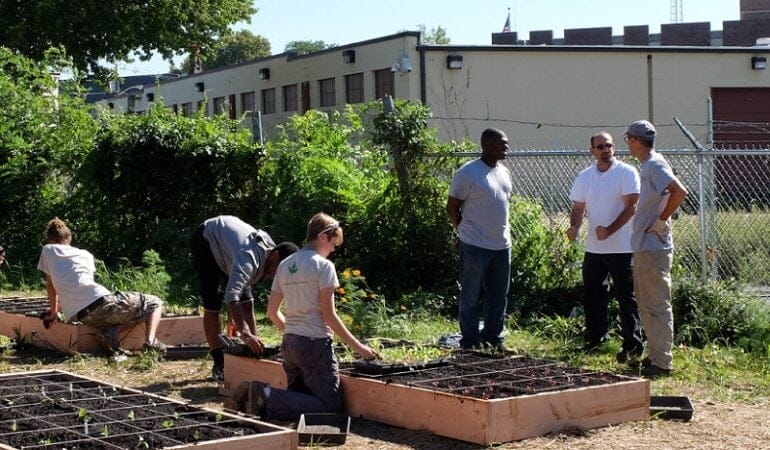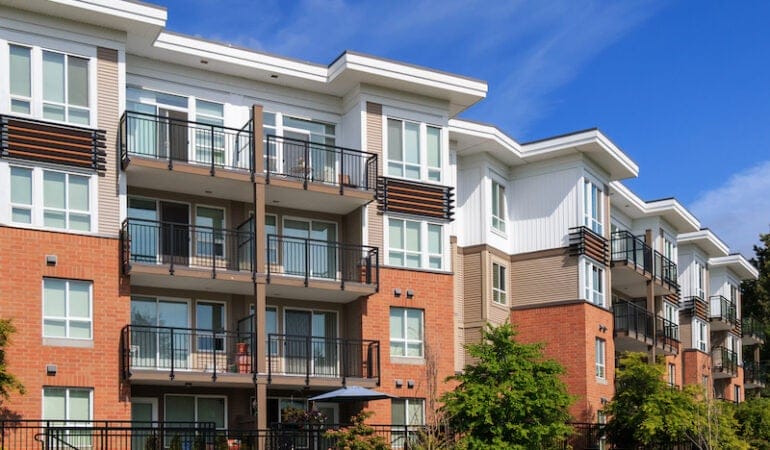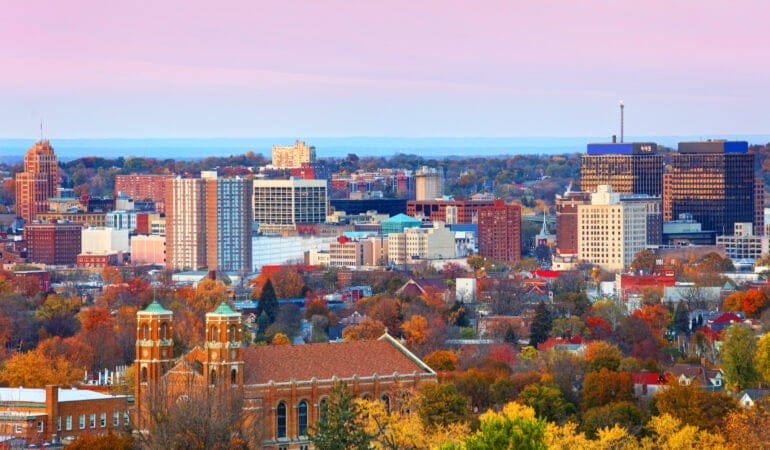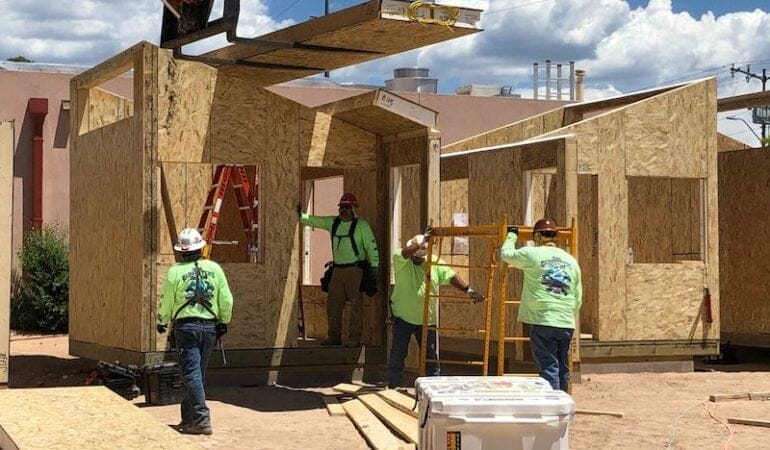Este es un extracto de un nuevo Enfoque en Políticas de Suelo, Through the Roof.
En los últimos 50 años, los hogares de los Estados Unidos, en particular los de alquiler, han sufrido un cambio drástico en su presupuesto. Los alquileres aumentaron y los ingresos no les siguieron el ritmo; el resultado es que los hogares que alquilan destinan una parte cada vez mayor de su ingreso a tener un techo. La proporción de inquilinos con carga de alquiler (que dedican más del 30 por ciento de sus ingresos al alquiler) aumentó de menos de un cuarto en 1960 a casi la mitad en 2016. Resulta más impactante que, en ese mismo período, la cantidad de hogares que alquilan y que tienen una carga muy alta (destinan más de la mitad de sus ingresos al alquiler) aumentó del 13 al 26 por ciento. Los costos de vivienda también aumentaron para los propietarios. Si bien muchos estudiosos se centran en la escasez de viviendas asequibles en ciudades costeras como San Francisco y Nueva York, la carestía ha aumentado en todo el país.
La evidencia demuestra que la carga que representan estos costos son importantes. Según ciertos estudios experimentales, los vales federales para elección de vivienda, que pagan una parte del alquiler y reducen considerablemente la probabilidad de quedarse sin techo, también mejoran los resultados de las pruebas estandarizadas (Schwartz et al. 2020). Los niños que viven en viviendas sociales tienen más probabilidades que otros niños en la misma línea de pobreza de tener seguridad alimentaria y clasificar como “bien” en el indicador compuesto de salud infantil. Posiblemente, esto se deba a que sus padres pueden costear alimentos más nutritivos (March et al. 2009). Incluso los aumentos pequeños en los ingresos disponibles pueden mejorar los resultados en educación y salud (Duncan, Morris y Rodrigues 2011).
En este informe se analizan las causas raíz y las consecuencias de la creciente falta de viviendas asequibles. Un motivo por el cual los hogares dedican mucho más presupuesto a la vivienda es que sencillamente no podemos proveer las unidades necesarias para suplir la demanda creciente en muchas ciudades donde ciertas regulaciones estrictas del uso del suelo y una creciente oposición del movimiento NIMBY (No en mi patio trasero) dificultan y encarecen la construcción. Pero puede que la falta de innovación y la aversión por los riesgos en el sector de la construcción también contribuyan. Y también lo hace la falta de lotes edificables en muchos lugares donde la gente quiere vivir. Otros factores posibles son la menor cantidad de entidades involucradas en el desarrollo de viviendas y la posesión de propiedades, el mayor flujo de inversiones mundiales y la mayor participación de grandes firmas financieras en la industria de la vivienda. Estas tendencias dan forma al tipo de construcción que se erige y elevan los costos de la vivienda y de las cargas. Las tendencias de construcción que prefieren las unidades más grandes, los cambios en la estructura económica y la mayor desigualdad en los ingresos profundizan aún más la brecha entre alquileres a precio de mercado y el presupuesto de las familias de ingresos bajos y moderados que necesitan un lugar donde vivir.
Con las amplias fuerzas de mercado que se ejercen, puede que haya quienes duden de si el gobierno puede hacer algo para cambiar la situación. En este informe se sostiene que la respuesta es afirmativa: todos los niveles del gobierno pueden tomar medidas cruciales para mejorar drásticamente la capacidad de pago. Los gobiernos locales en particular, con su poder sobre el uso del suelo, códigos de edificación, permisos e impuestos a la propiedad, se encuentran en una situación propicia para idear estrategias de vivienda efectivas y de base amplia, que aumenten la disponibilidad y la capacidad de pago. Estos dependen de subsidios federales y estatales para viviendas, pero, en general, tienen cierto criterio al determinar la mejor forma de estructurar los programas y políticas que usan dichos fondos.
Las estrategias locales de vivienda más efectivas son cabales y equilibradas, con lo cual tienen más probabilidades de obtener el apoyo político de la amplia coalición de intereses que se necesitan para fomentar los cambios de políticas deseados. Deben incorporar todo el conjunto de herramientas disponibles para los gobiernos locales, como subsidios, incentivos fiscales, regulaciones del uso del suelo y permisos para reformas. Además, fomentan cuatro objetivos que se refuerzan entre sí: crear y preservar unidades exclusivas de vivienda asequible; reducir los obstáculos a las incorporaciones; ayudar a los hogares a acceder y costear viviendas del mercado privado; y proteger contra el desplazamiento y las malas condiciones de las viviendas.
Tendencias de asequibilidad
La crisis actual de asequibilidad tiene raíces profundas. Desde 1970, las medianas de alquiler han aumentado muchísimo más que las medianas de ingresos (ver figura 1A, en la página siguiente). Entre 1960 y 2016, la mediana de ingresos aumentó cerca del 11 por ciento real, mientras que el valor real de la mediana de alquileres brutos (que incluye los costos de servicios públicos) aumentó un 80 por ciento. Esa es la cruel realidad en cifras. Es más, parece que los alquileres aumentaron implacablemente, incluso en los 70 y en la primera década del siglo XXI, cuando la mediana de ingresos real sufrió una caída.
En la figura 1B (en la página siguiente) se muestra que la diferencia entre el crecimiento de los alquileres y los ingresos fue aún más pronunciada en el extremo inferior de la cadena: los alquileres del percentil 25 aumentaron un 94 por ciento entre 1960 y 2016, mientras que los ingresos del percentil 25 aumentaron solo un 7 por ciento. Pero los alquileres superaron a los ingresos en toda la cadena. En la figura 1C se muestra el mismo patrón, aunque menos pronunciado, para el percentil 75 de ingresos y alquiler. Los saltos más drásticos en las cargas de alquiler se dieron en las décadas de 1970 y 2000. En resumen, todos los inquilinos destinan al alquiler una proporción mayor de su ingreso que hace algunas décadas. Para las personas con ingresos por debajo de la mediana, esto significa menos dinero restante para otros gastos.
Según la evidencia, los hogares con alta carga de alquiler gastan menos en bienes y servicios esenciales. En el informe de 2018 “State of the Nation’s Housing” (“Estado de las viviendas de la nación”), elaborado por el Centro Conjunto de Harvard para el Estudio de la Vivienda, se indica que en 2016 los inquilinos del cuartil inferior de ingresos con carga de alquiler gastaron casi US$ 650 menos en bienes y servicios no relacionados con la vivienda (como alimentos, atención médica y transporte) que los hogares del cuartil inferior sin carga de alquiler (Centro Conjunto de Harvard para el Estudio de la Vivienda 2018). Sandra Newman y Scott Holupka (2014) coinciden en su conclusión de que las familias de bajos ingresos con mayores carestías de vivienda gastan menos en actividades que enriquecen a los niños.
La función del gobierno local
Considerando el poder que tienen las acciones del gobierno local para abordar la crisis de asequibilidad de viviendas, sorprende que su función esté tan poco definida y que reciba un respaldo tan deficiente. No hay consenso acerca de qué implica una estrategia local de vivienda y ni siquiera de que toda comunidad debería tener una. En contraste con la amplia red de defensores, think-tanks e investigadores centrados en las políticas federales de vivienda, solo un puñado de organizaciones se dedican a ayudar a los gobiernos locales a desarrollar estrategias de vivienda más efectivas. Además, hay muy pocas investigaciones formales que evalúan cuáles son las estrategias más efectivas.
En un intento por definir mejor la función del gobierno local y desarrollar una guía basada en la evidencia para sus dirigentes, en 2015 los autores reunieron una comunidad de práctica sobre políticas locales de vivienda: 14 de los mejores especialistas de todo el país, quienes, en su mayoría, trabajan en ciudades muy costosas. El grupo central de trabajo incluyó a un miembro del ayuntamiento, comisionados de la vivienda (en ejercicio y retirados), desarrolladores privados y sin fines de lucro, entidades crediticias, intermediarios del desarrollo comunitario, asesores y dirigentes comunitarios. La comunidad de práctica identificó los seis principios de panorama completo que se enumeran a continuación, para definir y guiar a los gestores de políticas. Todos ellos se describen con más detalle en el informe.
- Las políticas locales de vivienda son importantes. Los municipios pueden hacer muchas cosas para mejorar la capacidad de pago. De hecho, los gobiernos locales están mejor posicionados que otros niveles del gobierno para liderar las labores y hacer frente a sus problemas de vivienda.
- Toda comunidad debe tener una estrategia local de vivienda. Si bien casi todas las ciudades y condados tienen una o más políticas que afectan a la asequibilidad y otros resultados de la vivienda, la mayoría no desarrolló una estrategia formal . . . Lo importante es iniciar el proceso de desarrollo de una estrategia formal con metas bien articuladas, herramientas de políticas y métricas para registrar el avance.
- Los municipios deben desarrollar enfoques cabales que reflejen las políticas de múltiples organismos locales. La coordinación puede resultar difícil, pero dado que en muchas jurisdicciones las dificultades son multifacéticas y complejas, los gobiernos locales que implementan varias herramientas para hacer frente a sus problemas de vivienda tienen posibilidades de hacer avances más significativos.
- Las estrategias locales de vivienda deben ser equilibradas. Es importante pensar en todo el abanico de necesidades para maximizar la aceptación política de la estrategia y la probabilidad de que esta tenga buenos resultados.
- Involucrar a un grupo diverso de partes interesadas para que los municipios puedan desarrollar estrategias efectivas y bien implementadas. Los funcionarios deberían involucrar a los miembros de la comunidad, en particular la gente de color y de bajos ingresos y los grupos marginados desde el comienzo del proceso. Al incluirlos, la estrategia que se elabore será más sólida y ayudará a evitar demoras en la implementación. Además, invertir en la participación comunitaria mejora la relación a largo plazo entre el gobierno y la comunidad, para los procesos futuros de planificación.
- Las estrategias locales de vivienda deben incluir objetivos mensurables y un proceso de elaboración de informes para garantizar la responsabilidad. Algunas ciudades adoptaron objetivos en función de la cantidad total de unidades asequibles o de vivienda que se crearon. Estos objetivos numéricos de panorama completo ayudan a medir y describir el avance, y los gestores de políticas y el público los entienden fácilmente. Sin embargo, suelen omitir matices importantes, como el tamaño de las unidades, los niveles específicos de ingresos de los hogares que pueden pagarlas y la cercanía a escuelas buenas y transporte público . . . Al adoptar una serie de metas, en vez de un solo objetivo, se puede entender mejor el progreso de la comunidad.
Acerca de los autores
Ingrid Gould Ellen es profesora de la cátedra Paulette Goddard de políticas y planificación urbana de la Escuela Superior Wagner de Servicios Públicos de NYU, y directora del cuerpo docente en el Centro Furman para Bienes Raíces y Políticas Urbanas de NYU.
Jeffrey Lubell es director de Iniciativas Comunitarias y de Vivienda en Abt Associates.
Mark A. Willis es miembro sénior de políticas en el Centro Furman para Bienes Raíces y Políticas Urbanas de NYU.
Referencias
Duncan, Greg J., Pamela A. Morris y Chris Rodrigues. 2011. “Does Money Really Matter? Estimating Impacts of Family Income on Young Children’s Achievement with Data from Random-Assignment Experiments”. Developmental Psychology 47: 1263–1279.
Centro Conjunto de Harvard para el Estudio de la Vivienda. 2018. “2018 State of the Nation’s Housing”. Cambridge, MA: Universidad de Harvard (junio). https://www.jchs.harvard.edu/sites/default/files/reports/files/Harvard_JCHS_State_of_the_Nations_Housing_2018.pdf.
March, Elizabeth L., Stephanie Ettinger de Cuba, Annie Gayman, John Cook, Deborah A. Frank y Alan Myers. 2009. “Rx for Hunger: Affordable Housing”. Boston, MA: Children’s HealthWatch y Medical-Legal Partnership (diciembre).
Newman, Sandra J. y Scott C. Holupka. 2014. “Housing Affordability and Investments in Children”. Journal of Housing Economics 24: 89–100.
Schwartz, Amy Ellen, Keren Horn, Ingrid Gould Ellen y Sarah Cordes. 2020. “Do Housing Vouchers Improve Academic Performance? Evidence from New York City”. Journal of Policy Analysis and Management 39(1): 131–158.





